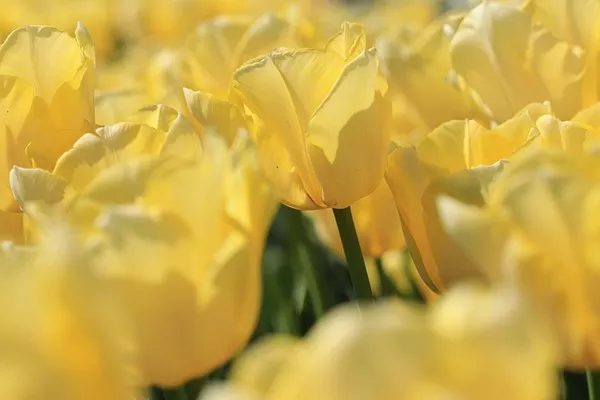In a world filled with diverse cultures and traditions, there are numerous celebrations that hold special meaning for people across the globe. One such unique and charming celebration is Yellow Flower Day. This special day, dedicated to the vibrant yellow blooms, has gained popularity for its association with joy, positivity, and the beauty of nature. In this article, we will explore the origins and significance of Yellow Flower Day, delving into the cultural, psychological, and environmental aspects that make it a noteworthy occasion.
Historical Roots of Yellow Flower Day
Yellow Flower Day is believed to have its roots in ancient traditions that celebrated the arrival of spring and the blossoming of flowers. Spring, with its colorful and fragrant blooms, has always been a symbol of renewal, hope, and joy. Yellow flowers, in particular, were cherished for their bright and cheerful appearance, representing the sun and the warmth it brings after the cold winter months.
The precise origin of Yellow Flower Day remains somewhat elusive, but it is clear that the celebration has transcended cultural boundaries and has become a global phenomenon. Many cultures have embraced the idea of dedicating a day to the beauty and symbolism of yellow flowers, creating a shared appreciation for nature’s wonders.
Symbolism of Yellow Flowers
Yellow flowers are rich in symbolism, making them the perfect candidates for a day dedicated to positivity and joy. The color yellow is often associated with happiness, energy, and optimism. Flowers, as a whole, have symbolic meanings in various cultures, and when combined with the color yellow, they take on an even more profound significance.
Sunflowers, daffodils, marigolds, and tulips are just a few examples of yellow flowers that are celebrated on Yellow Flower Day. Sunflowers, with their radiant yellow petals, are particularly emblematic of the sun and its life-giving energy. Daffodils symbolize renewal and the promise of a new beginning, while marigolds are often associated with positive energy and good fortune.
The celebration of Yellow Flower Day provides an opportunity for individuals to express their emotions, whether it be through the gift of yellow flowers or by surrounding themselves with these cheerful blooms. The act of gifting yellow flowers is considered a gesture of spreading happiness and conveying positive intentions.
Cultural Significance
Yellow Flower Day transcends cultural boundaries, making it a celebration that resonates with people from various walks of life. In many cultures, flowers play a significant role in religious ceremonies, festivals, and rituals. The use of yellow flowers in these contexts often signifies purity, enlightenment, and spiritual growth.
In some Asian cultures, yellow is associated with wealth and prosperity, further elevating the significance of Yellow Flower Day as a time to attract positive energies and abundance. The cultural diversity surrounding the celebration of Yellow Flower Day highlights the universal appeal of joy and positivity that yellow flowers represent.
Psychological Impact of Yellow Flowers
Color psychology suggests that different colors can evoke distinct emotions and influence mood. The color yellow, being bright and uplifting, is known to stimulate feelings of joy, warmth, and optimism. Yellow flowers, therefore, have a positive impact on mental well-being and can be used as a simple yet effective way to lift spirits.
The act of receiving or giving yellow flowers on Yellow Flower Day can create a sense of connection and shared positivity among individuals. The visual appeal of yellow blooms has the power to evoke smiles, reduce stress, and create a more optimistic outlook on life. Incorporating yellow flowers into one’s surroundings, whether through floral arrangements or potted plants, can contribute to a vibrant and uplifting atmosphere.
Environmental Awareness
Yellow Flower Day also serves as a reminder of the importance of environmental conservation and appreciation for the natural world. Flowers, including yellow blooms, play a crucial role in ecosystems as they support pollinators, contribute to biodiversity, and add beauty to the environment.
The celebration encourages individuals to take a moment to appreciate the beauty of nature and recognize the role that flowers play in sustaining life on Earth. Additionally, it promotes sustainable practices, such as choosing locally sourced and ethically grown flowers, to minimize the environmental impact associated with flower cultivation and distribution.
See Also What Makes Hydrangea Flowering Plants Change Blossom Colors
Conclusion
Yellow Flower Day has emerged as a delightful and meaningful celebration that unites people around the world in the spirit of joy and positivity. Whether through cultural traditions, the symbolism of yellow flowers, psychological effects on mood, or environmental awareness, this special day resonates on multiple levels.
As we celebrate Yellow Flower Day, let us take a moment to embrace the beauty of yellow blooms, share the joy with others, and reflect on the positive impact that nature has on our well-being. In a world filled with challenges, Yellow Flower Day stands as a reminder that simple gestures, like the gift of yellow flowers, have the power to spread happiness and create a brighter, more optimistic future for all.


